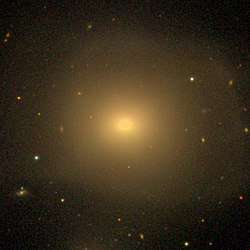NGC 3640
NGC 3640 is an elliptical galaxy located in the constellation Leo. It is located at a distance of circa 75 million light years from Earth, which, given its apparent dimensions, means that NGC 3640 is about 90,000 light years across. It was discovered by William Herschel on February 23, 1784.[3] It lies 2 degrees south of Sigma Leonis and is a member of the Herschel 400 Catalogue. It is condensed and can be spotted with a small telescope from suburban skies.[4]
| NGC 3640 | |
|---|---|
 NGC 3640 by SDSS | |
| Observation data (J2000 epoch) | |
| Constellation | Leo |
| Right ascension | 11h 21m 06.8s[1] |
| Declination | +03° 14′ 05″[1] |
| Redshift | 0.004330 ± 0.000017 [1] |
| Helio radial velocity | 1,298 ± 5 km/s[1] |
| Distance | 75.4 ± 25 Mly (23.1 ± 7.7 Mpc)[1] |
| Apparent magnitude (V) | 10.3 [2] |
| Characteristics | |
| Type | E3 [1] |
| Apparent size (V) | 4′.0 × 3′.2 [1] |
| Other designations | |
| UGC 6368, CGCG 039-130, MCG +01-29-033, PGC 34778[1] | |
Characteristics
NGC 3640 is an elliptical galaxy with a highly disturbed stellar component.[5] The galaxy features boxy isophotes, and patchy shell-like features. These features indicate a recent merger with a smaller gas-poor galaxy. A dust lane is observed along the minor-axis, spanning 30 arcseconds in a north-south direction. The galaxy has a high rotational velocity, estimated to be 120 ± 10 km/s, higher than that of other elliptical galaxies of similar luminosity.[6] The HI mass of the galaxy is estimated to be 1.85×107 M☉ and the mass of HII less than 7.44×107 M☉.[7]
In the centre of NGC 3640 lies a supermassive black hole whose mass is estimated to be roughly 100 million (107.99 ± 0.39) M☉ based on the Sérsic profile.[8]
Nearby galaxies
NGC 3640 is the foremost galaxy in a galaxy group known as the NGC 3640 group. Other members of the group include NGC 3630, NGC 3641, NGC 3643, and NGC 3664.[9] NGC 3640 forms a pair with NGC 3641, which lies 2.5 arcminutes south from NGC 3640. The group belongs to the Leo II groups, a large collection of galaxies belonging to the Virgo supercluster scattered across 30 million light years of space west of the Virgo cluster.[10]
References
- "NASA/IPAC Extragalactic Database". Results for NGC 3640. Retrieved 2016-01-18.
- "Revised NGC Data for NGC 3640". spider.seds.org. Retrieved 25 November 2018.
- Seligman, Courtney. "NGC 3640". Celestial Atlas. Retrieved 19 November 2018.
- O'Meara, Steve (2007). Herschel 400 Observing Guide. Cambridge University Press. p. 128. ISBN 9780521858939.
- Tal, Tomer; van Dokkum, Pieter G.; Nelan, Jenica; Bezanson, Rachel (1 November 2009). "The Frequency of Tidal Features Associated with Nearby Luminous Elliptical Galaxies From a Statistically Complete Sample". The Astronomical Journal. 138 (5): 1417–1427. arXiv:0908.1382. Bibcode:2009AJ....138.1417T. doi:10.1088/0004-6256/138/5/1417.
- Prugniel, P.; Nieto, J.L.; Bender, R.; Davoust, E. (October 1988). "The 'normal' elliptical galaxy NGC 3640 - A merger in progress?". Astronomy and Astrophysics. 204 (1–2): 61–67. Bibcode:1988A&A...204...61P. ISSN 0004-6361.
- Welch, Gary A.; Sage, Leslie J.; Young, Lisa M. (10 December 2010). "The Cool Interstellar Medium in Elliptical Galaxies. II. Gas Content in the Volume-limited Sample and Results from the Combined Elliptical and Lenticular Surveys". The Astrophysical Journal. 725 (1): 100–114. arXiv:1009.5259. Bibcode:2010ApJ...725..100W. doi:10.1088/0004-637X/725/1/100.
- Dullo, Bililign T.; Graham, Alister W. (November 2014). "Depleted cores, multicomponent fits, and structural parameter relations for luminous early-type galaxies". Monthly Notices of the Royal Astronomical Society. 444 (3): 2700–2722. arXiv:1310.5867. Bibcode:2014MNRAS.444.2700D. doi:10.1093/mnras/stu1590.
- Makarov, Dmitry; Karachentsev, Igor (21 April 2011). "Galaxy groups and clouds in the local (z∼ 0.01) Universe". Monthly Notices of the Royal Astronomical Society. 412 (4): 2498–2520. arXiv:1011.6277. Bibcode:2011MNRAS.412.2498M. doi:10.1111/j.1365-2966.2010.18071.x.
- "The Leo II Groups". atlasoftheuniverse.com.
External links

- NGC 3640 on WikiSky: DSS2, SDSS, GALEX, IRAS, Hydrogen α, X-Ray, Astrophoto, Sky Map, Articles and images
- NGC 3640 on SIMBAD